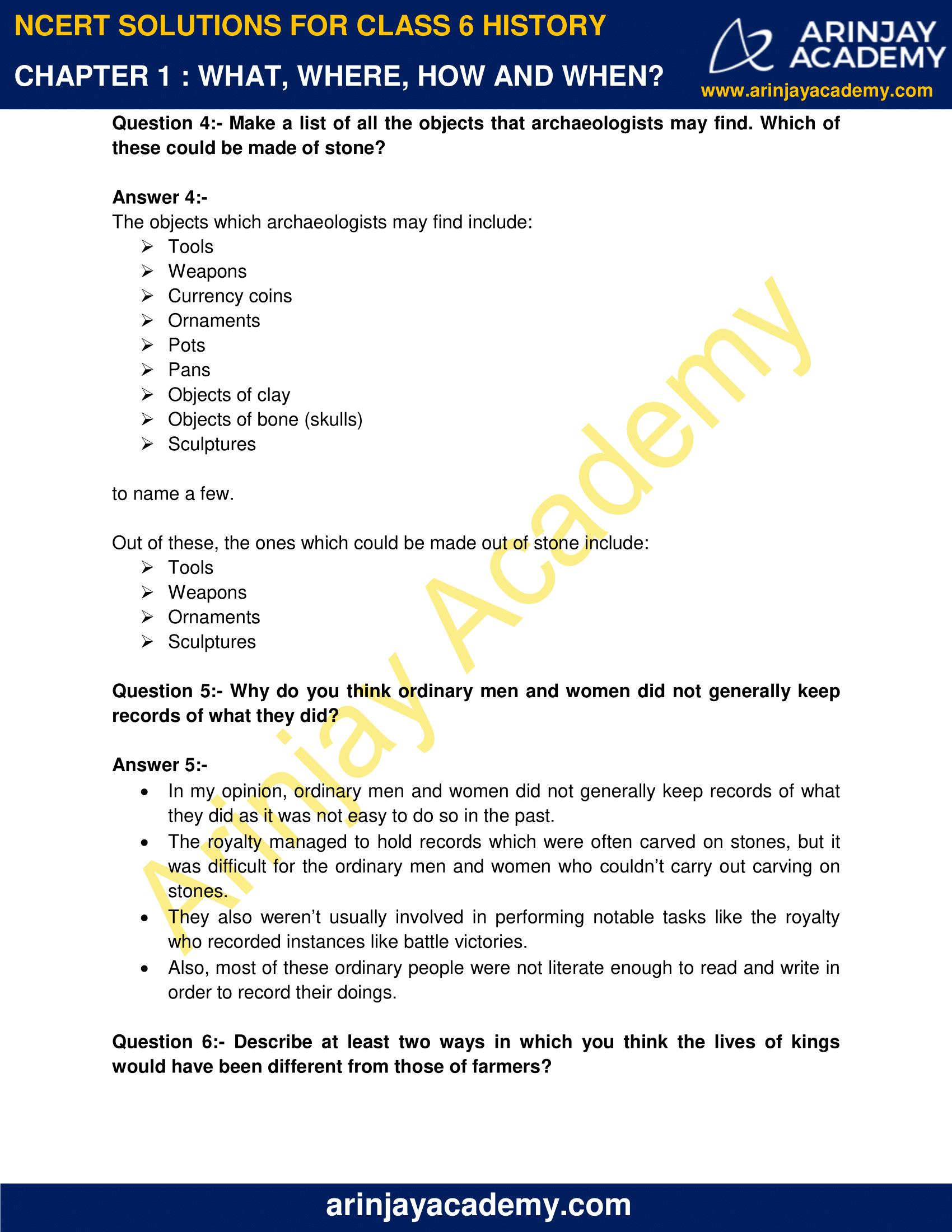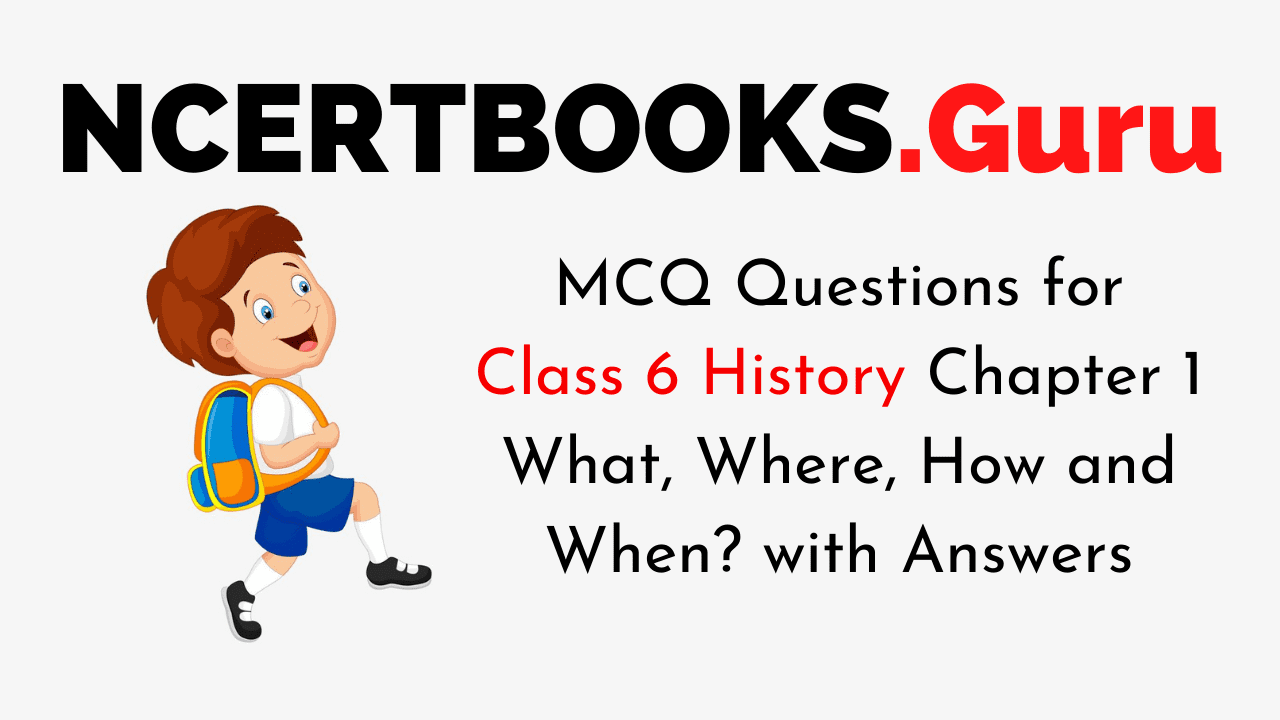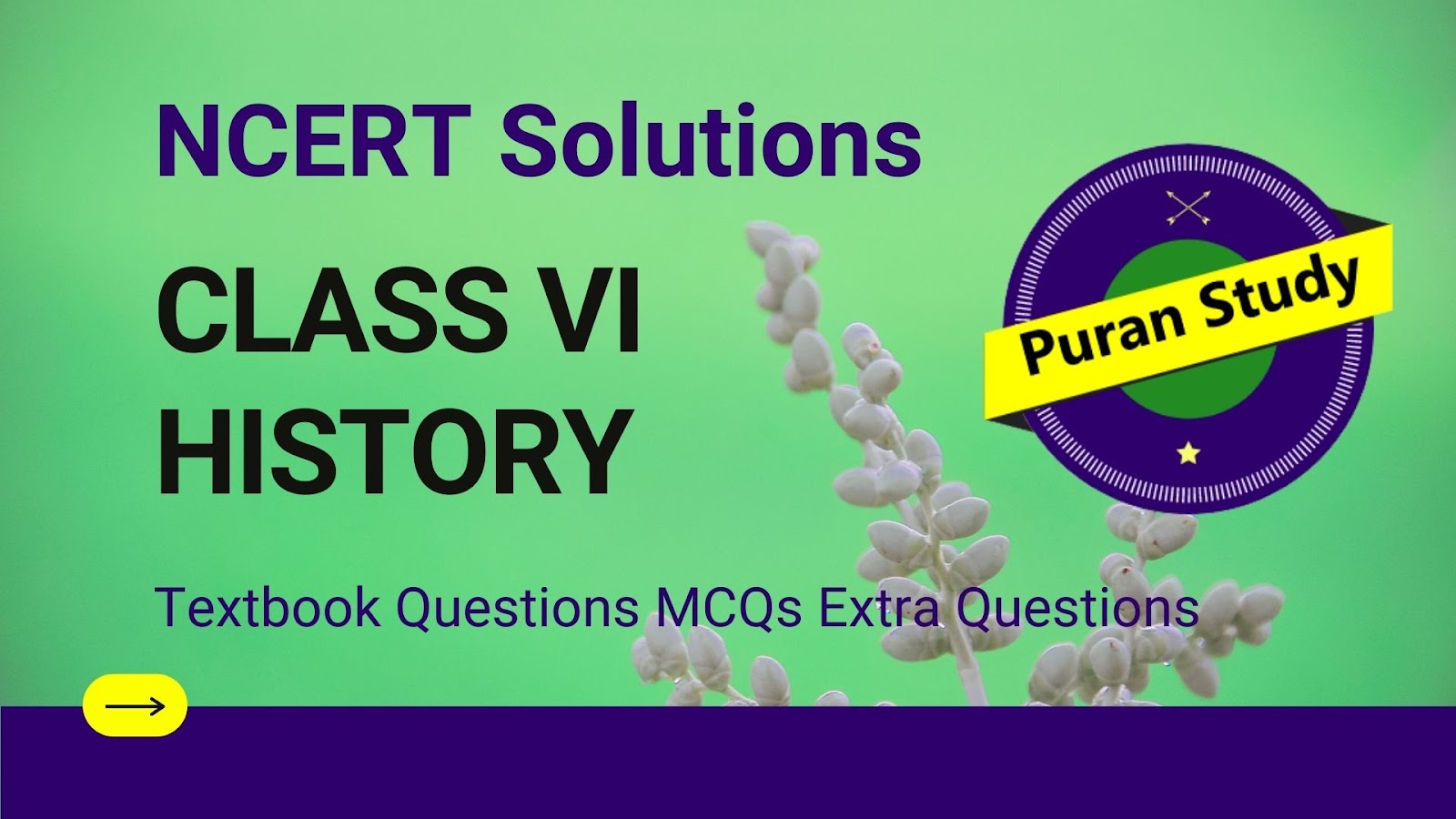
NCERT Solutions for Class 6 History Chapter 1 What, Where, How and
1. Match the following: 2. List one major difference between manuscripts and inscriptions. Answer: 3. Return to Rasheeda's question. Can you think of some answers to it? Answer: One can know what had happened so many years ago through these ways: 4. Make a list of as. the objects that archaeologists may find. Which of these could be made of stone?

Class 6 History Chapter 1 What, Where, How and When? English NCERT
Class 6 Extra Questions and Answer History Chapter 1 Very Short Answers Type Question 1. How can we know about the past? Answer: By studying History, we can know about the past. Question 2. Where did people live in the early period? Answer: In the early period, people lived on the banks of the river Narmada for several hundred thousand years.

NCERT Solutions for CBSE Board Class 6 Embibe
Extra Questions for Class 6 Social Science Geography : The Earth: Our Habitat. Chapter 1 The Earth in the Solar System. Chapter 2 Globe Latitudes and Longitudes. Chapter 3 Motions of the Earth. Chapter 4 Maps. Chapter 5 Major Domains of the Earth. Chapter 6 Major Landforms of the Earth. Chapter 7 Our Country India.

NCERT Solutions for Class 6 History Chapter 1 What, Where, How and
Chapter 6 Kingdoms, Kings and an Early Republic Chapter 7 New Questions and Ideas Chapter 8 Ashoka, The Emperor Who Gave Up War Chapter 9 Vital Villages, Thriving Towns Chapter 10 Traders, Kings and Pilgrims Chapter 11 New Empires and Kingdoms Chapter 12 Buildings, Paintings, and Books Class 6 Social Science NCERT Solutions

NCERT Solutions for Class 6 Social Science History Our Past Chapter1
Chapter 1 What, Where, How and When? Class 6 Extra Questions Chapter 2 On The Trial of the Earliest People Class 6 Extra Questions Chapter 3 From Gathering to Growing Food Class 6 Extra Questions Chapter 4 In the Earliest Cities Class 6 Extra Questions Chapter 5 What Books and Burials Tell Us Class 6 Extra Questions

NCERT Class 6 History Chapter 1 What, Where, How & When? (Er. Ankit
All the answers are created keeping in mind the understanding capacity of Class 6 students. NCERT Solutions for Class 6 History contains important chapters and topics of History from NCERT books for Class 6. Students can access 2023-24 solutions for all the questions in PDF format and solve them for free.

MCQ Questions for Class 6 History Chapter 1 What, Where, How and When
Answer: Rice was first grown to the north of the Vindhyas. History Chapter 1 Class 6 Extra Questions Question 5. Why do we use the words 'CE' and 'BCE' while referring to dates? Answer: The letters CE stand for Common Era and it is used in place of A. D. The letters BCE (means Before Common Era) and used instead of B.C.

CLASS 6 NCERT HISTORY CHAPTER1 WHAT WHERE HOW AND WHEN YouTube
Question 1. Write events against the following important dates: about 3000 years ago. about 2500 years ago. about 2300 years ago. about 1500 years ago. Answer: Question 2. What is the most important power with the people in a democracy? Answer: The people can choose their own rulers in a democracy. Question 3.

NCERT History Class 6 Chapter 1 தமிழ் What, Where, How and When YouTube
In this page, you will find extra questions for Chapter 1 What, Where, How and When Class 6 History which includes variety of questions such as VSAQs, SAQs, LAQs and HOTS. These are very essential in knowing the chapter properly. You will get to know important questions for Chapter 1 Class 6 History which are very helpful in the preparation of examinations.

NCERT Chapter 1 Solution For Class 6 History (SSt)
Question 1. Who composed later Vedic books? Answer: Later Vedic books were composed by priests. Question 2. Where is Varna system described? Ans. Varna system is described in the Vedas. Question 3. In which area were social and economic differences not very sharp and influence of the priests was limited? Answer:

NCERT Solutions for Class 6 History Chapter 1 Introduction What
NCERT Extra Questions for Class 6 Social Science History Chapter 1 What, Where, How and When? What, Where, How and When? Class 6 Extra Questions Very Short Answer Type Question 1. How can we know about the past? Answer: We can know about the past by studying history. Question 2. Where did the early people live? Answer:

NCERT CLASS 6 HISTORY CHAPTER 1 What, where, how and when? (PART 2
CBSE Class 6 History extra questions include questions that may probably be asked in the exam again and cover the major concepts from all chapters of the subject. Students can solve these extra questions for practice and revise the subject thoroughly for the exam.

NCERT Solutions For Class 6 History Chapter 1 What, Where, How and
Answer Question 4. Which of the following hills are located in North-east (a) Vindhya Hill (b) Garo hills (c) Narmada Hills (d) Satpura Hills Answer Question 5.

NCERT Class 6 History Chapter 1 What, Where, How And When chapter
NCERT Class 6 History Chapter 1 Extra Questions - Fill in the blanks. 1) Men and women moved in search of livelihood and escape from natural calamities. 2) The name India was given by the Iranians and the Greeks. 3) The bark of the birch tree was used to prepare manuscripts. 4) Inscriptions were written on hard surfaces like stones, and metals.

NCERT Class 6 History Chapter 1 क्या, कब, कहाँ और कैसे YouTube
Solution: 1. What is Archaeology? 2. What does an Archaeologist do? 3. What is the process involved in excavation? 4. How do archaeologists determine the age of any of the objects discovered from excavations? 5. Why are symbols important in the field of Archaeology? Let's Recall 1.Match the following Solution 1:

NCERT Class 6 History Chapter 1 WHAT, WHERE, HOW AND WHEN? Part 2
Answer: True 11: What was the source of food for most of the people living in Andaman Islands? Answer: Fishing, forest products and hunting. 12: What is an inscription? Answer: Inscriptions are writings on relatively hard surface such as stone or metal. 13: Name the leaf on which Manuscripts in Ancient period were usually written? Answer: Palm leaf